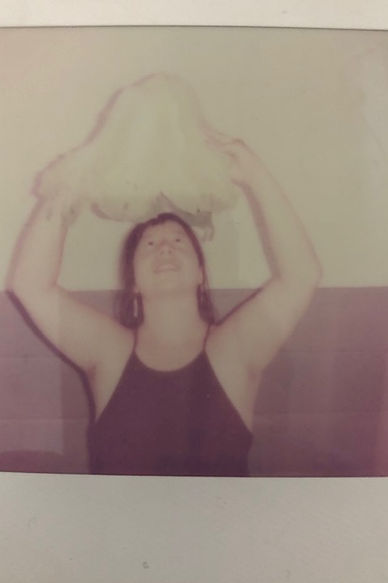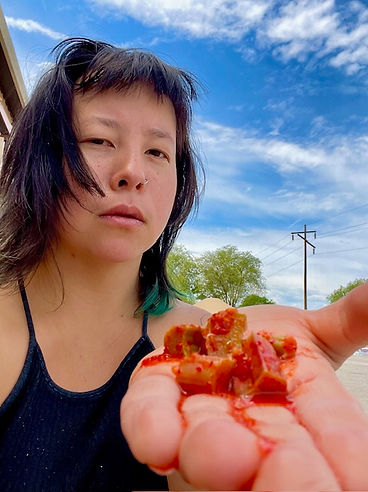손Sohn-Made Kimchi김치
Jung-a's Mission
Jung-a’s makes the kind of (mixed Korean American) kimchi you would eat at home. All batches are sohn 손 (hand)-made with vegetables from local farmers and/or organically grown produce. It’s about reconnecting with the stories of our food and where our food comes from; making food with our own hands with intention & care; sharing food together as a local community, as well as honoring our relationship with the land, the plants and animals that make home on the land, and with the long lines of hands.
Jung-a's Story
In the heart of the pandemic, Ariel/Jung-a was working with a small group of kids in a learning pod formed by several families. She decided to share with them a little bit about fermentation and her Korean heritage. There's no better way than to make kimchi. It turned out to be a really bad batch. She called her oma (엄마, mom) for some help, who then suggested she talk with her emo (이모, aunt). Emo 이모 said she could make some kimchi jjigae and told her about Maangchi, a sweet and funny Korean lady who shares a lot of K-food recipes on YouTube. Meeting Maangchi filled her with countless recipes she had grown up eating, and sharing them with friends made her belly and soul very happy, helping her to connect more with who she is, her family and where they come from. She made dishes and dishes of various Korean foods, samgyeopsal 삼겹살, bibimbap 비빔밥, mandu guk 만두국, and many more.
She eventually slowed down, but started taking it back up in 2023. Part of this coming back to making kimchi is because of a performance she did called Drip Baby Drip, which pieced together dance, voice, text, sounds and food making. Drip drew from Heena Baek’s children’s book Moon Pops, which re-interprets the Korean folklore about the rabbit(s) in the moon making rice cakes. It’s a story about the moon melting, the rabbits losing their home and then returning again. The moon melts because it is much too hot. The granny wolf runs out to catch the moon's drippings, turns them into moon pops and offers them to her neighbors to help them cool down. Soon, she gets a visit from the rabbits who live in the moon that has just melted away. Granny wolf has a "moon-sprout idea," pouring the last of the moon’s drippings into a pot, from which a primrose starts to grow, and from the flower a light grows bigger and bigger back into the moon. Through the performance, Ariel shared her own moon story, turning fermentation, the process of washing, chopping and salting (the beginning of making kimchi), into a metaphor for becoming her own mother. 달이 떨어진다, daree duruh jeendah, a translation from her mother, is a phrase from the performance that shows up in places here and there in Jung-a's project as a way to continue this message of personal fermentation. Kimchi 김치 has become a kind of mother. She finds out from her friend one week as they were walking by the tall grass by the ponds and birds on the waters at Freeze Out Lake that this phrase actually translates to the moon has dropped/fallen. They had a good chuckle ㅋㅋㅋ. 달이 뚝뚝 흘러내린다 (daree dduk dduk hulleo-naereenda) was what she was going for, the moon is dripping (in a more liquid way, rather than dropping piece by piece or shedding something, which was what her omma had offered as a translation. To keep a little piece of her omma in Jung-a's, she is not changing the original 달이 떨어진다.
This is a story of someone fermenting into a fermenting obsession, about falling in love with baechu (napa cabbage), about reconnecting with family roots, about learning traditional Korean food making, and about sharing that with all of you.

Sohnmat 손맛
Jung-a’s makes everything with her own hands. 손맛 Sohnmat is in your hands, literally it means “hand-taste.” Sohnmat is really at the core of Korean cooking. Sohnmat is generational; the microbiome of our ancestors is passed down all the way to us. When someone is said to have sohnmat, it elicits a “damn, they really know how to make food.” Their food is enlivening, really wakes up your cells. You could say a feeling of home and your childhood is embedded in the layers of their food too, often so are the memories of your omma (mom) and her food.
Sohnmat gets you closer to the foods you are with. It’s really rooted in your senses and your memory - you just know how much sogeum (salt) to add to the baechu (napa cabbage), how to shape the noodles by fanning out the dough with your thumb for sujebi (hand-torn noodle soup).
Who drew the hands?

Mayo Osawa drew the hands and the moon, the cabbage mountains, the cabbage flowers (yes those are the flowers that grow from a napa cabbage) and the river.
Mayo grew up in Tokyo, Japan, and now lives in Missoula, MT. She loves cooking, baking, upcycling clothing, painting, making jewelry and whatever is available at hand.
Creating the logo was a collaborative process, with Ariel's floating ideas of the cabbage mountains, the generational hands and the pink moon, and Mayo's compositional strengths, bringing it all together with the clouds, sky and river.
About the kimchi maker




My name is Ariel Sohn Brand. You can also call me Jung-a (정아). Jung-a is the name my wei-halmoeni (할머니, grandma) gave to me. My oma (엄마, mom) is from Seoul, South Korea. My dad was raised in New York City with Hungarian Jewish parents. I was born and raised in the suburbs of Connecticut.
Besides having a minor kimchi obsession, I relish in weird, vulnerable edges, guavas, maracuya and mangos, aikido falls, dancing, usually dancing, unschooled artistry, the ocean, hablando español, Frida, funky grooves, and listening to Rosalia. My background is in making art, literature, poetry, learning Spanish, growing up on the east coast and now living in Montana for nearly the last 10 years, counseling, working with kids and families in various school contexts, performance art, somatics (a process that involves observing our internal and external experiences) and more recently food - researching the history of Korean food, wanting to know more about the history of food in the US, about indigenous foods and food sovereignty, and Asian American history, integrating philosophy, traditions, and art with food.
Since starting my own kimchi business in 2024, I continue to gather a deeper understanding of the tradition of making kimchi, of the philosophical and cultural implications of this tradition, as well as what it means to have a personal and collective connection with food. Kimchi has opened up new places of connection with myself, with others, with the land, and with the various communities within Missoula.
Though Korean food is usually passed down generation to generation, I didn’t learn how to make Korean food from my family. Traditionally, it’s the ommas 엄마 who have done the cooking at home. My wei-halmoeni 할머니 was a doctor, and so she devoted most of her time to her work. Since their maids were the ones who did most of the cooking, my oma 엄마 never learned how to make Korean food. So I had to learn a different way. It feels as if there’s been a severance in connection to some of our family history, and making kimchi is my way of coming back to it.
I started making Korean food from Maangchi, a v. special Korean lady who shares numerous Korean recipes on Youtube. I owe a lot to her for helping me to get closer to my roots. She is in a way my my Korean food mother 엄마.
And I know I’m not the only one - there are many many stories of her deep influence in our stories of reconnecting with our Korean parts. Since then, I’ve branched out, reading several cookbooks, listening to podcasts, experimenting with different ways to make kimchi, going to Korea with my oma 엄마 and emo 이모 (aunt), eating different kinds of kimchi that I haven’t had in a long time, eating baechu kimchi in different parts of Korea - each place has their own special touch.
Exploring my roots throughout my life has moved as waves do, coming and going. This was the first time I felt that I was connecting more strongly with my Korean-ness and because I can’t speak very much hanguk-eo 한국어 (Korean), making food has been turning into its own language. The more I learn about traditional Korean food making, about fermentation, and about the process of making kimchi, I feel something I can’t really explain in words.
Imagine peeling a full cabbage’s skin, pulling each leaf from the outside to the inside, one by one, getting closer to the center. I like to think of this image as I work to make my sohnmat (손맛) stronger. Sohnmat, meaning "hand-taste," is knowing naturally how to make a dish. It also refers to how the food we cook tastes particular to ourselves, because we’ve made it with our very own hands. Since our microbiomes travel from one generation to the next, so does our sohnmat. Though I really wish we had my haelmonee’s 할머니 way of making kimchi, I wonder if Jung-a’s kimchi is at all like what she made.
The funny thing is that my middle name/our family name, Sohn (손), means hand. My hands are of my oma’s 엄마 hands, of my haelmonee’s 할머니 hands, of my jungjo haelmonee’s (증조 할머니, great grandma) hands, and a long line of hands, washing, chopping, salting, and mixing.